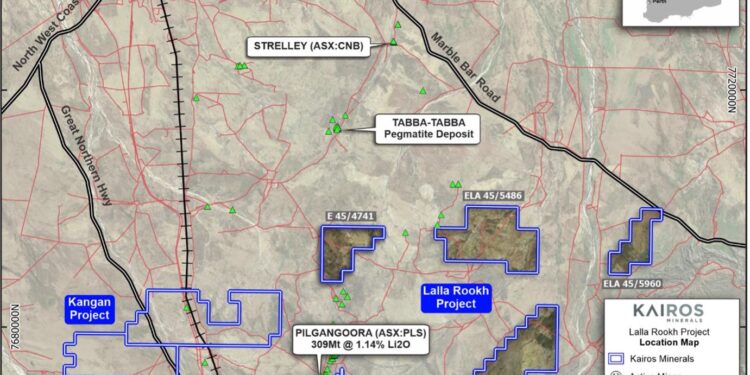Kairos Minerals Ltd (ASX: KAI) has identified a series of significant large-scale Lithium-Caesium-Tantalum (LCT) pegmatite targets prospective for lithium mineralisation within its 100%-owned Lalla Rookh Project, located in the East Pilbara region of Western Australia.
The targets were identified as part of an ongoing review of the company’s exploration portfolio for lithium exploration opportunities.
Executive Chairman, Terry Topping, said a review of regional datasets including satellite imagery, aeromagnetics, radiometrics and gravity data has highlighted numerous large-scale regional structures that represent priority targets for follow-up mapping and sampling.
“An ongoing review of the lithium prospectivity of our portfolio has yielded further exciting results, with a detailed review of regional datasets identifying a number of large lithium-caesium-tantalum pegmatite targets at Lalla Rookh,” Mr Topping said.
“The strategic location of our tenements just 25km from one of the largest lithium deposits in the world at Pilgangoora added further impetus to our review of the lithium potential of this area.
“We have planned an extensive heli-borne mapping and sampling program that will commence next month to fast-track our evaluation of these extensive targets. Subject to the results, we will move quickly to refine areas for potential drilling as part of our 2022 exploration field season.
“This adds another exciting dimension to our growing Pilbara lithium portfolio, and we are looking forward to getting on the ground in the near future.”
Lalla Rookh Project (EL 45/4741 and ELAs 45/5486, 45/6018, 45/5960)
The Lalla Rookh Project comprises one granted Exploration Licence (E45/4741) and four applications (ELAs 45/5486, 45/6018, 45/5960), covering a total area of 342 sq. km.
The Project is located 75km south of Port Hedland, south of the Tabba-Tabba tantalum deposit and Strelley pegmatite site (42km), and 25km north of Pilbara Minerals’ world-class Pilgangoora Lithium Mining Centre.
The company has identified extensive new Lithium-Caesium-Tantalum (LCT) targets at the 100%-owned Lalla Rookh Project. The tenement E45/4741 is notably prospective for LCT pegmatites.
The major lineaments in the region that extend into the E45/4741 tenement could act as a pathway for mineralised fluids enriched in elements such as lithium, caesium, tantalum, and beryllium, as has occured in pegmatites in the surrounding areas.
This work has identified the extension of the structures observed in the magnetics survey (local and regional) Lalla Rookh associated with the pegmatites at Pilgangoora (~25km) and a historical beryl mine located ~4km to the south.
E45/4741 is mapped as predominantly granites of the Split Rock and Sisters Supersuite intrusions. The Split Rock Supersuite rocks in the area mainly consist of monzogranites that intrude older units of the Sisters Supersuite.
The Split Rock unit is prospective for LCT pegmatites and intrusion-related gold mineralisation. A review of satellite imagery has highlighted several regional scale structural targets and local offset features, which are extensions of major structures that host a historical beryl mine.
Pegmatite rock chip samples analysis from this site returned impressive results for Li2O (0.57% and 0.30%) and pathfinder elements for LCT pegmatites’ pathfinder elements (Rb, Cs, Be).
Four high-priority LCT targets defined in the tenement EL 45/4741 are extensions of major lineaments observed in aerial satellite images with up to ~4 km strike and trend N-NNE.
Next Steps
• Field exploration at Roe Hills Project.
• Soil geochemistry sampling results from the Mt York, Kangan, Skywell and Croydon Projects. • Additional heritage surveys at Kangan and Skywell Projects.
• Assay results from the Mt York RC drilling.
• Assay results from the Kangan AC in-fill drilling.
• Field exploration of regional LCT pegmatite targets
For further information please visit: https://www.kairosminerals.com.au/












